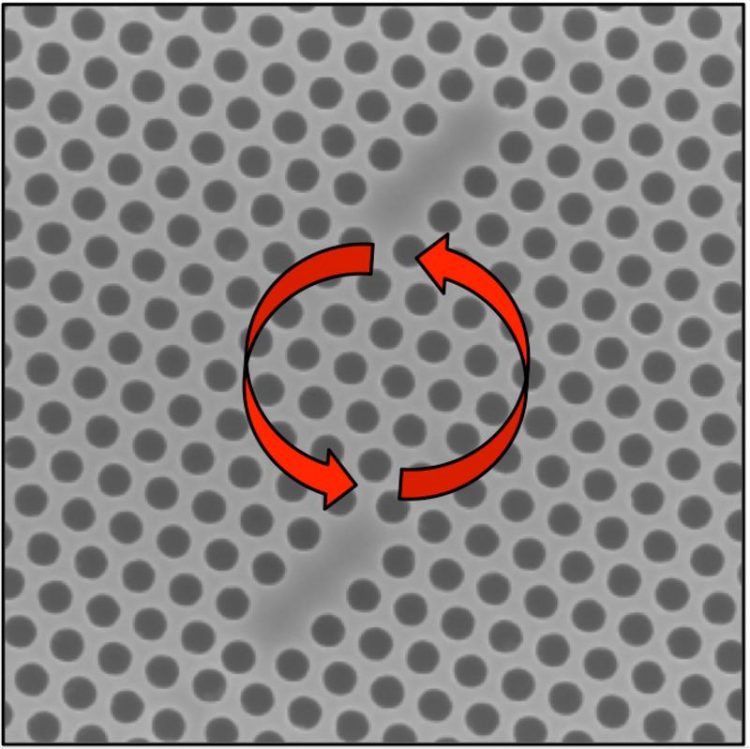A swinging molecule of light

The acoustic nanoquake switches on the bond between the two nanoresonators of the photonic molecule. Then single photons jump back and forth as indicated by the red arrows. © H. Krenner
For their experiments NIM-graduate student Stephan Kapfinger and his supervisor Hubert Krenner at the chair of Experimental Physics I (Prof. Achim Wixforth) at Augsburg University used nanometer-thin membranes of semiconducting material into which they drilled a large periodic array of tiny holes using cleanroom nanofabrication.
In such a structure, a ‘photonic crystal’, light of well-defined energy (or color) can be trapped inside a region where three holes are skipped, thus forming a tiny ‘defect’ and acting as a nanocavity. Together with the group of Dr. Michael Kaniber and Prof. Jonathan Finley at TUM, they designed and fabricated a structure of two adjacent nanocavities, in which photons, single quanta of light, can oscillate back and forth.
“In our photonic molecule, photons behave just like electrons, which create a chemical bond in a hydrogen molecule. While the two hydrogen atoms forming an H2 molecule are totally identical by nature, the two artificial, man-made nanophotonic cavities usually are not,” Stephan Kapfinger explains. Until now, these tiny nanoscale imperfections have hampered the realization of coupled photonic elements or even larger scale photonic circuits.
The Augsburg research team used a smart trick to solve this pressing problem: they designed and employed a tiny sound wave, a nanometer earthquake on a chip, such that it compresses one of the nanocavities and simultaneously stretches the other.
This way, they are able to overcome the tiny fabrication related imperfections and make the two nanocavities identical for a very short snatch. Moreover, this happens also at a precisely defined time during the cycle of the sound wave, thus providing total control over the coupling.
Stephan Kapfinger is really enthusiastic on the success of his experiment: “It was fascinating to see that the two nanocavities don’t emit at the same color as one would naively expect. In fact they “repel” each other and the difference is simply the bond strength of the photonic molecule! Many scientists have tried hard to measure this effect but with little success.”
Hubert Krenner notes: “Our hallmark experiment not only demonstrates scaling and control at unprecedented speed. It also shows that nanomechanical waves can be efficiently converted to optical signals. This is quantum-mechanical control in the truest sense of the word.” The pioneering work and longstanding expertise of the Augsburg group on the application of surface acoustic waves (SAW) led to numerous important results and application. These cover the entire spectrum of the very active field of nanoscience and attracted large attraction worldwide. “We are very happy, that surface acoustic waves, our special tool for which we are famous here in Augsburg, led to another outstanding result in the field of nanophotonics,” Achim Wixforth proudly adds.
The studied photonic crystal devices are highly attractive because they can be scaled to large integrated circuits for light even in the quantum regime. Based on their groundbreaking experiments, the NIM research team expects that this system can now finally be extended to an optical quantum computer. Shaking and rattling them using well defined nanoquakes will be the clock of the quantum processor.
This work is supported by the Deutsche Forschungsgemeinschaft (DFG) via the Emmy Noether Programme (KR3790/2-1) and Sonderforschungsbereich SFB 631, and by the Excellence Initiative via the Cluster of Excellence Nanosystems Initiative Munich (NIM).
Reference:
Stephan Kapfinger, Thorsten Reichert, Stefan Lichtmannecker, Kai Müller, Jonathan J. Finley, Achim Wixforth, Michael Kaniber and Hubert J. Krenner
Dynamic acousto-optic control of a strongly coupled photonic molecule
Nature Communications 6, 8540 (2015), doi:10.1038/ncomms9540
Link: http://dx.doi.org/10.1038/ncomms9540
Contact:
Prof. Hubert Krenner – hubert.krenner@physik.uni-augsburg.de
Prof. Achim Wixforth – achim.wixforth@physik.uni-augsburg.de
Lehrstuhl für Experimentalphysik I
Universität Augsburg
Universitätsstraße 1
86159 Augsburg
Telefon +49(0)821-598-3308
http://www.physik.uni-augsburg.de/de/lehrstuehle/exp1/emmynoether/
http://dx.doi.org/10.1038/ncomms9540
http://www.physik.uni-augsburg.de/de/lehrstuehle/exp1/emmynoether/
Media Contact
All latest news from the category: Physics and Astronomy
This area deals with the fundamental laws and building blocks of nature and how they interact, the properties and the behavior of matter, and research into space and time and their structures.
innovations-report provides in-depth reports and articles on subjects such as astrophysics, laser technologies, nuclear, quantum, particle and solid-state physics, nanotechnologies, planetary research and findings (Mars, Venus) and developments related to the Hubble Telescope.
Newest articles

Webb captures top of iconic horsehead nebula in unprecedented detail
NASA’s James Webb Space Telescope has captured the sharpest infrared images to date of a zoomed-in portion of one of the most distinctive objects in our skies, the Horsehead Nebula….

Cost-effective, high-capacity, and cyclable lithium-ion battery cathodes
Charge-recharge cycling of lithium-superrich iron oxide, a cost-effective and high-capacity cathode for new-generation lithium-ion batteries, can be greatly improved by doping with readily available mineral elements. The energy capacity and…

Novel genetic plant regeneration approach
…without the application of phytohormones. Researchers develop a novel plant regeneration approach by modulating the expression of genes that control plant cell differentiation. For ages now, plants have been the…





















